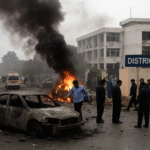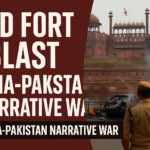By Ch.Haroon Rashid
Pakistan’s Defence Minister Rekindles Fears of Another Indo-Pak Showdown
⚠️ The Return of War Rhetoric
The war drums are beating again in South Asia.
In a striking televised statement, Pakistan’s Defence Minister Khawaja Asif warned that the “chances of war with India are real,” vowing that if conflict erupts, Pakistan “will achieve a better result than before.”
His comment instantly revived the uneasy memory of the May 2025 India–Pakistan crisis, when missile strikes and border clashes brought both nations to the brink of open warfare.
But this is not an isolated outburst — it’s the culmination of months of growing hostility, domestic pressures, and regional realignments. The following timeline captures how “war talk” gradually returned to Pakistan’s political vocabulary.
“India was never united except under Aurangzeb,” Asif claimed, linking history to national destiny. “Pakistan was created in the name of Allah — we will stand by that.”
Such statements fuse religion, nationalism, and deterrence — a mixture designed to rally the home front while signalling strength abroad.
🕰️ Timeline of Escalation (April – October 2025)
Date
Event / Statement
Source
Apr 28 2025
Asif warns a military incursion by India is imminent
Reuters
Apr 30 2025
Pakistan claims Indian strike “within 36 hours” possible
Reuters
May 7 2025
India launches Operation Sindoor – cross-border strikes
Wikipedia
May 10 2025
Ceasefire declared after three days of hostilities
Wikipedia
Jun 5 2025
Asif calls the Simla Agreement a “dead document”
Economic Times
Aug 14 2025
Pakistan forms the Army Rocket Force Command
Wikipedia
Sep 17 2025
Pakistan & Saudi Arabia sign Strategic Mutual Defence Pact
Wikipedia
Oct 8 2025
Asif reiterates “chances of war are real”
Economic Times
Each milestone reflects a progressive tightening of rhetoric and policy — from verbal warnings to institutional restructuring — suggesting that Pakistan’s strategic posture is being recalibrated rather than merely voiced.
🔍 From Words to Warning — What’s Driving Asif’s Tone?
1. Domestic Pressure & Public Unity
Despite deep political divides, few issues unite Pakistanis like external threats. Asif’s invocation of faith and history transforms security policy into a collective moral cause, consolidating internal consensus.
2. Regional Positioning
Following Operation Sindoor, Islamabad faces pressure to project resilience. The creation of the Rocket Force Command and the Saudi Defence Pact are deliberate steps to reinforce deterrence and demonstrate credible alliances.
3. Strategic Messaging to India and the West
By amplifying threats, Pakistan reminds New Delhi, Washington, and Riyadh that it remains a decisive regional actor whose stability—or instability—matters. This calculated assertiveness helps Islamabad negotiate from a perceived position of strength.
⚔️ India’s Counter-Signals
India’s Defence Minister Rajnath Singh recently warned that “one route to Karachi passes through Sir Creek,” a pointed geographical metaphor interpreted as a veiled threat.
New Delhi’s response balances firmness with caution, ensuring that its deterrence language matches Pakistan’s without crossing the red line into provocation.
While both nations insist they seek stability, the rhetorical exchange has transformed the subcontinent into an arena of psychological warfare, where every phrase carries strategic weight.
🧩 Beyond Rhetoric — Deterrence or Brinkmanship?
Analysts note that Asif’s “war talk” is less about immediate conflict and more about strategic signalling:
•Deterrence Reaffirmed: Reasserting Pakistan’s readiness after the May 2025 setbacks.
•Domestic Legitimacy: Rallying unity during economic stress.
•External Leverage: Drawing attention from allies and adversaries alike.
However, constant escalation in tone risks normalizing aggression. The danger lies not in intent but in misperception—one misread signal could turn rhetorical deterrence into unintended confrontation.
🧠 Conclusion — Between Deterrence, Perception, and Reality
Pakistan’s renewed “war talk,” embodied in Khawaja Asif’s statements, represents a sophisticated form of strategic theatre. When open war becomes too costly, perception itself becomes a battlefield.
Three analytical dimensions define this phase:
1.Deterrence Signalling: Asif’s language aims to restore confidence at home and communicate red-lines to India. It serves as an asymmetric equalizer after Operation Sindoor and asserts that Pakistan’s deterrent credibility remains intact.
2.Ideological Mobilization: By invoking religion and history, the government intertwines military resolve with moral legitimacy, ensuring emotional mobilisation of the populace — a critical element of wartime psychology.
3.Strategic Posturing: Institutional reforms, such as the Army Rocket Force Command and the Saudi Defence Pact, mark a gradual evolution toward proactive deterrence. Yet these same moves narrow diplomatic flexibility, raising the risk of escalation through misjudgment.
In the final analysis, Asif’s remarks underscore a shifting doctrine: Pakistan’s defence narrative is moving from reactive survival to psychological deterrence.
Both Islamabad and New Delhi now operate in a realm where narratives, optics, and deterrence psychology are as decisive as missiles and divisions.
In South Asia, wars no longer begin with tanks — they begin with words.










